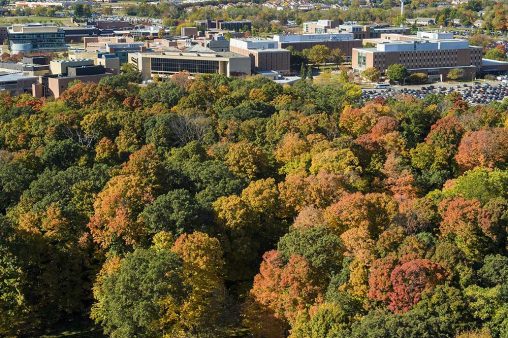
The sixth annual Runkle Woods Symposium on Nov. 17 will showcase research inspired by the Wright State University woods on the Dayton Campus.
Bird watching in the Wright State University woods, an overview of pawpaws and the economics of conservation are among the topics that will be explored during Wright State’s Runkle Woods Symposium.
The Runkle Woods Symposium will take place on Friday, Nov. 17, from 1 to 4 p.m., in 016 Rike Hall. The event is free and open to students, faculty, staff and the public.
Featuring faculty and students from the College of Science and Mathematics and the College of Liberal Arts, the symposium showcases research inspired by the Dayton Campus woods. The Wright State University woods is 225 acres of forest that is home to up to 110 species of birds as well as foxes, coyotes, deer, salamanders and the rare Indiana bat.
“The sixth annual Wright State University Runkle Woods Symposium will be a great one this year,” said symposium organizer Audrey McGowin, Ph.D., professor of chemistry.
The symposium is named after James Runkle, Ph.D., professor emeritus of biological sciences and a longtime woods researcher.
Jeffrey Peters, Ph.D., professor and associate chair of biological sciences, will deliver a keynote address on “Seasonal Changes in the Avian Community of the Wright State Woods.” In recent years, he has become an avid birder.
“Dr. Peters carries on the long tradition started by Dr. Runkle of monitoring the bird species that live in our woods and also the species that use them as a stopover on their migration routes,” McGowin said. “This is the first time we have had a presentation on birds in the symposium.”
Peters’ research program is interdisciplinary and includes aspects of molecular and evolutionary ecology, population and community genetics, molecular evolution and behavioral ecology. His research focuses on the evolutionary histories of populations and species using DNA sequences and the influence of natural selection on non-coding DNA.
He has published more than 50 papers in peer-reviewed journals, including Molecular Ecology, Austral Ornithology, the Journal of Avian Biology and Conservation Genetics.
Peters received his Ph.D. in biological sciences from the University of Maryland, Baltimore County, his master’s degree in applied ecology and conservation biology from Frostburg State University and his bachelor’s degree in biology from Indiana University of Pennsylvania. He served as a postdoctoral fellow from 2006–2008 at the University of Alaska Fairbanks.
Another highlight of this year’s symposium is a presentation on pawpaws, the state fruit, by Don Cipollini, Ph.D., professor of biological sciences.
“We have many pawpaw trees in the woods, but would you know how to identify them?” McGowin said.
Research presented at the symposium will be available on Wright State’s CORE Scholar.
Runkle Woods Symposium schedule:
1 p.m.: Welcome, Audrey McGowin, professor of chemistry
1:05 p.m.: “Economics of Conservation and the Application to the Runkle Woods,” Indigenous American Cultural Student Association, Brad Kerry, adjunct faculty member in economics, Eliza Hendrix, Mateo Bush and Ryan Diaz
1:30 p.m.: “Pawpaws: Ohio’s state fruit,” Don Cipollini, professor of biological sciences
2:10 p.m.: “The Insult of Road Salt,” Abigail Tuttle, Benson Sparkman, Landon Shackleford, and Audrey McGowin
2:30 p.m.: Keynote Address: “Seasonal Changes in the Avian Community of the Wright State Woods,” Jeffrey Peters, professor of biological sciences
3 p.m.: “National Wildlife Federation Habitat Certification: A Collaboration with Fairborn,” Alexis Knick and Amanda Taylor, Fairborn Environmental Advisory Board
3:20 p.m.: “Building Community through Nature,” Mikusa, Wright State Nature Club
3:30 p.m.: Send-Off Meditation

 Wright State University Foundation awards 11 Students First Fund projects
Wright State University Foundation awards 11 Students First Fund projects  Gov. DeWine reappoints Board Treasurer Beth Ferris and names student Ella Vaught to Wright State Board of Trustees
Gov. DeWine reappoints Board Treasurer Beth Ferris and names student Ella Vaught to Wright State Board of Trustees  Joe Gruenberg’s 40-Year support for Wright State celebrated with Honorary Alumnus Award
Joe Gruenberg’s 40-Year support for Wright State celebrated with Honorary Alumnus Award  Wright State’s elementary education program earns A+ rating for math teacher training
Wright State’s elementary education program earns A+ rating for math teacher training  Wright State’s Calamityville hosts its largest joint medical training operation
Wright State’s Calamityville hosts its largest joint medical training operation 